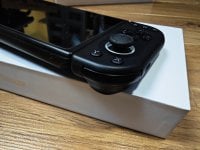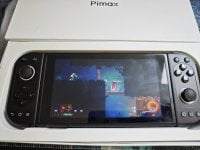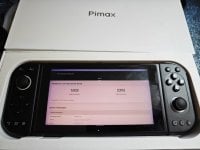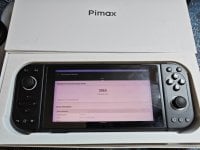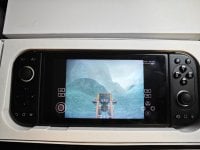Pimax Portal Impressions
If there’s ever been an appropriate time to be a handheld gamer, now is arguably the best time to be one. On one end of the spectrum there are retro handheld devices like the Anbernic RG405M and Miyoo Mini+ that lets us relieve games of yesteryear with enhancements; and on the other end of the spectrum are powerful gaming PC handhelds from companies like AYANEO, Steam and now ASUS that lets you play the latest AAA games on-the-go. In between those categories are streaming devices like the Logitech Cloud. Now add to the mix new (‘head’held) portable devices like the Meta Quest 3 and the Apple Vision Pro, portable gaming literally takes new dimensions. Now retro gaming, handheld PC gaming and VR gaming have traditionally been distinct categories with dedicated devices for each; but a new product aims to be all of it at once. Enter the Pimax Portal.
Launched via a Kickstarter campaign some months ago, the Pimax Portal is best described as a hybrid gaming device. It is now being shipped to backers and pre-orders for the retail version have also started today, with shipping to start in July. The latter model might differ from the Kickstarter version, which is the one under review, and this early model is meant for early adopters with changes expected for the retail model. There are also some features and accessories that are not yet available for a complete picture of what the Portal is capable of (based on its promise); hence, this article being an impressions piece rather than a full review.
Promises of an ambitious device
With Kickstarter early-bird pricing starting at $299 (and retail pre-orders at $369), the Portal is essentially an Android tablet with a modular design. It’s not unlike the Nintendo Switch as it also bears detachable controllers but these are magnetically attached as opposed to bearing a sliding mechanism. While I had some concerns about magnetic attachments, I was positively surprised by how well the controllers attach to the sides of the screen in the Portal. The strong magnets keep the controllers fixed in place and require some voluntary effort to detach them; meaning you can safely use the console for handheld gaming without worrying that the controllers will detach and cause the tablet to fall.
The reason these are detachable is for VR mode. With the companion VR headset, the screen module slots into the front, akin to the Google Daydream VR headset, and the controllers are attached onto dedicated mounts (see video below). The tablet portion features an array of cameras that allow for passthrough, akin to the Meta Quest, for standalone VR gaming. Pimax even teases at other Wii-like accessories for the controllers such as a tennis racket and a gun for added immersion in virtual reality. However, none of these VR add-ons are available at this time and VR mode on this device is not really usable without a headset. Pimax expects to have this mode ready in a few months’ time as well as the VR headset.
Pimax also has a dedicated dock planned for the Portal, allowing its screen content to be mirrored on a bigger screen. This could be a draw particularly for video game streaming. The product’s campaign also briefly mentions the Portal XL expansion. This expands the console’s screen and controller sizes by slotting them into their XL counterparts, which, coupled with the Pimax Mini station, allows for PC gaming “in certain scenarios” on an 8.8-inch screen with a refresh rate of 120hz. While additional details are currently lacking, Pimax has released an early prototype “teaser” of what the expansion will look like:
Sounds too good to be true? That’s a maybe, but also a maybe not. This is because even if the VR accessories and other Portal modules are not available to the public at this time, Pimax has prototypes and demos of these add-ons. In addition to the prototype Portal XL, the company has demoed the VR headset and VR mode to some YouTubers as you can see below. Pimax says that while VR mode is working, the headset needs some further fine-tuning before shipping them out.
So this leaves the Portal as a highly ambitious device that is currently best described as an Android gaming tablet. So let’s consider it in these terms for what’s currently possible with the device.
Hardware impressions
Even if it is an “early adopter” version, the hardware build of the backer Portal units is solid. It packs a polished, sturdy finish that delivers a satisfying feel when the device is held in the palms. This is supplemented by the device’s 367g weight which feels very light and comfortable to use and hold. The lightweight aspect will also be important for VR use as you won’t want a chunky headset pressing down on your nose and face.
As for the controllers, the buttons deliver a satisfying clicky feedback, which is comparable to the Switch’s keys. This is because they also use dome switches. While I prefer keys lined with a conductive rubber membrane for the nostalgic retro feel, the keys on the Portal are responsive. In addition, the Portal features analogue triggers which could be more appropriate for certain games, especially PC ones.
But like the Switch, the Pimax Portal does not feature a traditional D-pad but rather distinct buttons for each key. This is a downer for handheld gaming, especially retro gaming. However, this compromise might be explained for VR use as distinct buttons might be a better option in VR rather than a D-pad. Moreover, the modular aspect of the system and a planned ecosystem by Pimax means that a dedicated controller with a retro-styled D-pad might be possible in the future. That said, if you’ve used a Switch, you have probably gotten used to the layout sans D-pad and it will be the same with the Portal.
Of note, this handheld features some additional buttons on each controller that are not typical of other controllers. These can act as shortcut keys for Android gaming and probably have dedicated uses in VR.
As mentioned earlier, the controllers attach magnetically to the sides of the screen. The strong magnets hold the controllers tightly and securely in place, and can be removed with some voluntary force. The controllers can further be ‘stitched’ together to have a mini gamepad of sorts for tabletop gaming. The Portal’s design, while definitely inspired by the Switch, is well thought out to offer a quick and effective mechanism to switch between gameplay modes.
Overall, the Pimax Portal’s build left me positively impressed. It feels polished and well designed for its current use as an Android gaming handheld and future potential uses as a VR device.
Android gaming performance
On the software side, the Pimax Portal runs on Android 10 with a skin that makes the UI more akin to a gaming system. It also features some custom boot sounds and audio feedback which adds to the overall console feel of the experience. As it is Android-based, you can install your favourite apps from the Play Store whether it’s Android games, emulators or social media apps.
Specs-wise, this hybrid system features a Qualcomm Adreno 650 GPU and a Qualcomm Snapdragon XR2 CPU. While the device’s VR capabilities are not available for testing, what can be tested is its gaming prowess as an Android device.
On GeekBench 6, the device scores 1002/2393 on single/multi-core CPU, respectively and 3065 on GPU score. This makes the Portal a rather capable gaming device. It ran every Android game I threw at it flawlessly. Native Android games like Pascal’s Wager and Dead Cells play smoothly on high graphics settings. The Pimax Portal model with a QLED screen tested in particular delivers crisp visuals with vibrant colours that enhances the overall experience.
Pimax further has a buttons mapping feature that allows you to map the device’s buttons to on-screen controls for games that don’t natively support controller input such as Genshin Impact. This feature is what I consider a must-have for Android gaming devices and I was thrilled to see an effective one implemented on the Portal. And if you want, you can still play touchscreen-based games by using the Portal’s touchscreen and detaching the controllers.
This device is also well adapted for emulation, even if the 16:9 aspect ratio of its 5.5" display leads to black side bars for games with a 4:3 aspect ratio. Systems up to PS2 are great to play on the Portal, enabling even 2x scaling with smooth performance.
Pushing the Portal emulation limits further, you can even emulate some Switch games with emulators like Skyline. While I won’t recommend getting the Portal specifically to play Switch games, this option is quite welcome and impressive. Of course, it won’t play all games flawlessly but it can play some less demanding games decently such as Cuphead while more demanding titles like Super Mario Odyssey can just crash.
The built-in 3960mAh battery mileage will vary based on the games you play and systems you emulate. But on average, I would get about 2 hours of game time by swapping between Android and retro games.
So, as an Android gaming device, the Pimax Portal is more than decent. It’s more capable than most retro handheld devices out there and packs a sturdy build while being lightweight. The dedicated controls add that much-needed physical feel and the buttons mapping feature enables such a feel for games without native controller support.
Still a work in progress
However, the Pimax Portal is not meant to be just an Android gaming device. Its Kickstarter campaign promises as much but most of those promises have yet to materialise. Hence, a measure of caution is advised as usual with crowdfunded projects.
That said, while the Portal is Pimax’s first Android device, it is not their first crowdfunded campaign. They’ve released several VR headsets and have a decent track record in delivering on their promise.
Even with the Portal, they are quickly rolling out updates to further fine-tune the user experience. For example, when I first received the device, I could hear an audible buzzing sound when increasing brightness but this was fixed with a software update. Similarly, controllers had to be reconnected by pressing a button after every reboot but this need has been eliminated with an update.
However, there are a few more tweaks that would be welcome. For example, adjusting volume on the device isn’t very intuitive as two buttons need to be pressed. But Pimax told me that this could be addressed in a future update. Additionally, if you enter VR mode by mistake (it’s available via an app on the device), it’s very challenging to get back to the main screen. Maybe toggling VR mode on/off with one of the buttons (or a combination) would be more adequate. Also, the circular LED around the joysticks aren’t customisable at the moment but should be enabled in a future update.
Thus, a lot of the current issues with the Pimax Portal are software-based, most of which have been addressed while others could still be addressed in the near future. Of course, this is not ideal but hopefully these are ironed out when retail units roll out for non-backers. On the plus side though, the hardware has been pretty much nailed and retail units can be expected to be even better (maybe a D-pad option and/or membrane-lined face buttons).
In addition to the UI/UX tweaks, a lot hinges on dedicated VR software. Portal-compatible titles are not very clear but Pimax does have a storefront and the company told me that they already have a number of games coming for the system. As the Portal is a direct competitor to the Meta Quest and Pico, its library has to be as appealing, if not more so.
Then there are the other unreleased hardware accessories such as the VR headset, dock and Portal XL. The headset should be a priority at this point but adopters should also be able to avail of the rest of the ecosystem sooner rather than later.
This makes recommending the Portal a tricky affair. It has and promises lots of potential, unlike what other devices offer on the market. But most of its potentials haven’t been materialised yet. If you’ve backed the device for the early-bird price of $299, then you might have scored a decent deal but you’ll have to wait to enjoy all of its promises. If you’re looking for a good Android gaming device with some extra potential perks, then go for it. It’s great to play Android games and emulators, especially on the QLED screen variant, and has a button-mapping feature to play virtually any games with physical controls. But if you’re enticed about its other potentials, then it’s better to wait until the compatible accessories and software are available.
That said, the gaming industry needs such modular, out-of-the-box devices. It’s an exciting device that has been well designed but is just waiting on its ecosystem of accessories to unleash its full potential. I’m all for such a device if this potential is materialised as Pimax promises; and the Portal could truly stand up to its name to be a literal portal to a range of gaming options. Once the add-ons and VR mode are available to the public, a full review (or follow up impresions) will be undertaken to give a better picture of the product. For now, it’s well worth keeping an eye on developments on the device. Pimax has rolled out pre-orders for retail Portal units, and this means progress on the VR and accessories should be made soon. And maybe the portal to a gaming ecosystem spanning retro games to VR games will be accessible on a single device.
UPDATE:
13/09/2023: Yuzu is now compatible with the Pimax Portal's Android 10 OS thanks to developer Huesos_96. Pimax has also provided a comprehensive how-to guide to get the emulator running on the handheld.
13/09/2023: Yuzu is now compatible with the Pimax Portal's Android 10 OS thanks to developer Huesos_96. Pimax has also provided a comprehensive how-to guide to get the emulator running on the handheld.





